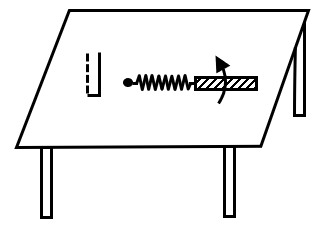A metallic rod of length 'l ' is tied to a string of length 21 and made to rotate with angular speed w on a horizontal table with one end of the string fixed. If there is a vertical magnetic field 'B' in the region, the e.m.f. induced across the ends of the rod is:

![]()
This problem involves electromagnetic induction in a rotating rod within a magnetic field. The rod of length is tied to a string of length , making the total distance from the fixed end (center of rotation) to the rod's end . The rod rotates with angular speed on a horizontal table, and a uniform vertical magnetic field is present.
The emf induced in a straight conductor moving perpendicular to a magnetic field is given by the formula for motional emf. For a rod rotating about one end, the emf induced between its center and end is , where is the length of the rod.
However, in this setup, the rod is not rotating about its own end. The string is fixed at one end, and the rod is attached to the other end of the string. So, the entire system rotates about the fixed end of the string. The rod is a rigid body, so every point on it has the same angular velocity .
To find the emf across the ends of the rod, we must consider the motion of the rod in the magnetic field. The induced emf in a small element of the rod at a distance from the center of rotation is , where is the linear velocity of that element.
The rod extends from (the point where it is tied to the string) to (the free end). Therefore, the total emf induced across the rod is the integral of from to .
Step 1: Set up the integral for emf.
Step 2: Evaluate the integral. Since and are constants, they can be taken out of the integral.
Step 3: Apply the limits.
Step 4: Simplify the expression.
Therefore, the emf induced across the ends of the rod is .
Motional EMF: The electromotive force generated in a conductor moving through a magnetic field. For a straight conductor of length moving with velocity perpendicular to a uniform magnetic field , the motional emf is .
Rotating Conductor: For a rod rotating about one end in a perpendicular magnetic field, the emf induced between the center and the end is , derived by integrating the emf induced in each infinitesimal element of the rod.
Faraday's Law: While this problem uses the concept of motional emf, it is a manifestation of Faraday's law of electromagnetic induction, which states that a changing magnetic flux induces an emf in a circuit.